Are you wanting your website to outshine the competition and secure the coveted #1 spot on Google for your most critical keywords? Achieving this goal requires mastering the art of SEO writing.
So, what exactly is SEO writing?
SEO writing refers to creating online content like blog posts that are optimized to rank on search engines through proper keyword usage and other on-page factors.
To maintain a stronghold on the Search Engine Results Pages (SERPs), you must consistently publish high-quality content, including blogs, videos, white papers, eBooks, and more, tailored to your target audience. However, it’s not just about creating content your audience loves; you must also adhere to SEO best practices to ensure search engine crawlers index and rank your content for relevant queries.
In essence, SEO writing marries the art of content creation with the science of search engine optimization. These two aspects are inseparable. Even with impeccable SEO optimizations, irrelevant or poorly written content won’t secure high rankings on search engines like Google. Conversely, flawlessly crafted content that delivers immense value to your audience won’t generate organic traffic without proper search engine optimization.
That’s why mastering SEO writing requires both strong writing skills and a deep understanding of SEO principles. Fortunately, we’ll be sharing ten valuable tips to equip you with both skills, so stay tuned.
What Sets SEO Writing Apart?
Writing for SEO sets itself apart from other forms of writing, which might initially perplex some writers. While the fundamentals of good writing—grammar, spelling, and sentence structure—remain crucial, SEO writing adds a layer of complexity through strategic keyword usage, header tags (H1, H2, H3, etc.), and extensive internal and external linking with optimized anchor text.
Additionally, character limits are a significant concern in SEO writing, something traditional writers seldom encounter. For instance, Google’s search results restrict title tags to a maximum of 60 characters, presenting a unique writing challenge. Meta descriptions also have a strict 160-character limit, while your H1 tag should stay within 60 characters.
Why such strict limits?
Exceeding these character limits for title tags or meta descriptions results in incomplete displays on Google’s search results, which can appear awkward.
This emphasis on keywords and character limits exemplifies what sets SEO writing apart. It goes beyond coherent sentences and paragraphs. SEO writing revolves around meeting specific search engine requirements while still producing top-notch content for your readers.
The distinctive challenges of SEO writing encompass:
- Integrating target keywords effectively without making the content seem spammy.
- Fitting target keywords into title tags, header tags, and meta descriptions within their stringent character limits.
- Presenting content in a reader-friendly format.
- Identifying the keywords your audience searches for and building content around them.
How SEO Writing Has Evolved Over Time
In the ever-changing landscape of SEO, SEO writing has undergone significant transformations, mirroring the dynamic nature of SEO itself.
Previously effective writing techniques have become obsolete in today’s context and may even incur penalties from Google. In the early days of search engines, the frequency of keyword usage within a post directly correlated with higher SERP rankings. This led to a surge in keyword-stuffed, low-value blog posts by site owners.
However, Google’s algorithms have grown increasingly adept at detecting and penalizing websites attempting to manipulate rankings instead of offering valuable content. Furthermore, the recent updates to Google’s Quality Rater Guidelines have reshaped the approach to SEO writing.
The well-known acronym E-A-T (Expertise, Authoritativeness, and Trustworthiness) now includes an additional “E” for Experience. To have your content deemed high-quality by the Google’s Quality Rater Guidelines, it’s imperative to demonstrate first-hand experience on the topic.
Additionally, SEO writers can target various SERP features like image carousels, Knowledge Bar, and Local Pack to enhance online visibility. Achieving a featured snippet placement, known as position zero (above organic search results), can be particularly rewarding.
These continual changes mean that SEO writing today differs significantly from its form just a year or two ago. Staying up to date with current guidelines, like the one provided here, is crucial.
Mastering SEO Writing: 10 Tips and Tricks
Becoming a proficient SEO writer doesn’t require literary genius; it hinges on understanding your audience’s preferences and the SEO strategies with the most impact. Once you grasp the essentials, you’ll effortlessly produce impeccably optimized content, including blogs, articles, landing pages, video scripts, and more.
Here are the ten pivotal tips that can elevate your SEO writing:
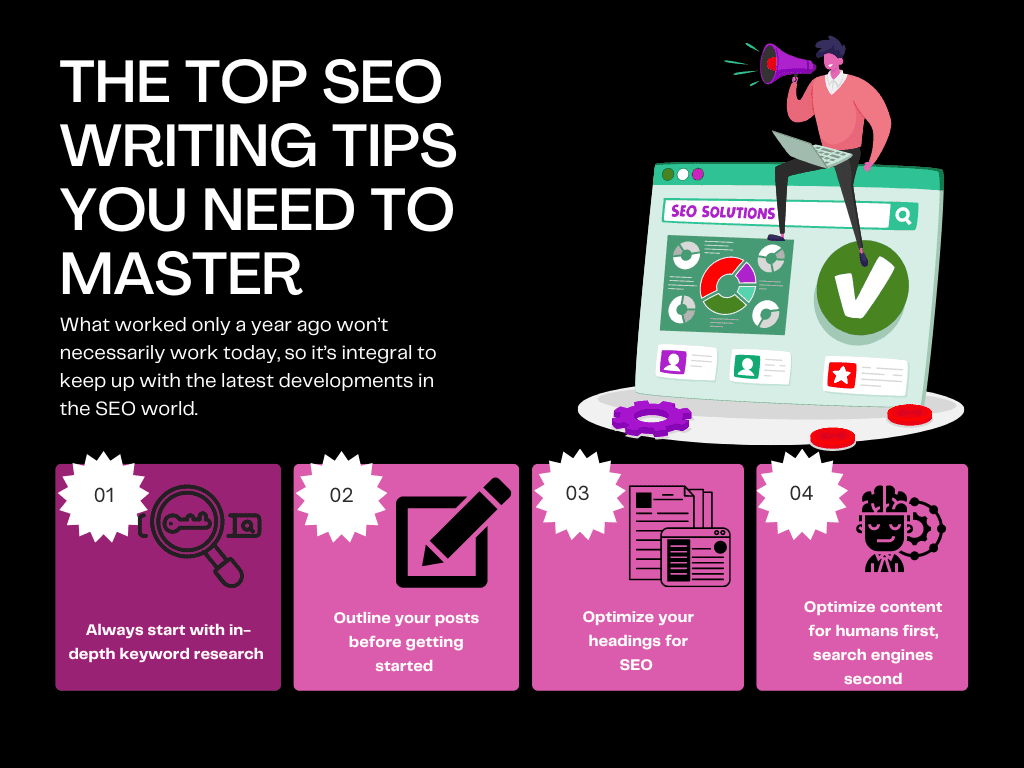
#1: Start Your SEO Writing with Keyword Research
Keywords are the lifeblood of SEO writing, as they represent the very terms your target audience actively searches for. By delving into keyword research, you uncover the content preferences of your audience.
Attempting to create content without preliminary keyword research is akin to writing in the dark or crafting content solely based on personal interests. What matters to you might not resonate with your audience, underscoring the importance of an informed content strategy underpinned by keywords.
Numerous methods exist for keyword research, but the simplest approach involves utilizing tools like our free keyword planner. After inputting a general keyword relevant to your niche, our planner generates a comprehensive list of real-world keywords predominantly searched for by your audience. These keywords provide clear direction on the type of content to create for optimal traffic generation.
For instance, consider the fitness niche, with a specialization in meal planning. When you enter ‘meal planning’ into our keyword planner, you might spot a keyword like ‘Mediterranean diet meal plan‘ with substantial search volume, a moderate keyword difficulty (KD) score, and a rising trend in popularity. This indicates a significant portion of your core audience is interested in planning meals for the Mediterranean diet. Consequently, crafting content like a blog post titled ‘How to Master Mediterranean Diet Meal Planning‘ becomes a logical choice.
Key Metrics to Focus On
The most crucial metrics to pay attention to are the following:
- Search Volume: This figure represents the volume of users actively searching for a specific keyword. Higher search volume equates to the potential for more traffic.
- Keyword Difficulty (KD) Score: A keyword’s difficulty score indicates the challenge of outranking competitors on the SERPs. Keywords with a high KD score (over 50) may necessitate alternative choices.
- Search Trend: Visualized as a trendline graph, this metric displays a keyword’s popularity over time. An upward trend indicates increasing interest, while a declining trend suggests waning user searches.
- Search Intent: Each keyword possesses an inherent intent, signifying what users hope to find when searching. Keyword intent categories include informational, navigational, commercial, or transactional.
In summary, ideal keywords exhibit high search volume, a moderate-to-low KD score, and a positive search trend. Your choice of search intent aligns with your specific objectives for each keyword. For instance, aiming to enhance brand visibility would lead you to informational intent keywords, while keywords with commercial and transactional intent are suitable for boosting conversions.
#2: Outline each piece of content
Once you’ve amassed a treasure trove of topic ideas from your keyword research, it’s time to construct a structured outline for each piece of content you intend to produce.
Having an outline at your disposal significantly streamlines the process of SEO writing, particularly when it comes to crafting blog posts.
Imagine, for instance, being tasked with composing a daunting 2,000-word blog post without the guidance of an outline. The endeavor may appear insurmountable. However, if you’re provided with an outline that breaks down the post into manageable 200-word sections, suddenly, the task becomes much more manageable.
Furthermore, working from an outline facilitates the incorporation of any necessary SEO enhancements.
Here’s a concise illustration of a typical blog post outline:
- H1: How to Master Mediterranean Diet Meal Planning
- Introduction – 200 words
- H2: What Constitutes the Mediterranean Diet? – 200 words
- H3: Exploring the Health Benefits – 200 words
- H2: Fundamentals of Mediterranean Meal Planning – 100 words
- H3: Breakfast – 200 words
- H3: Lunch – 200 words
- H3: Dinner – 200 words
- H2: Conclusion and Call to Action
This outline methodically specifies header tags and word counts, providing an effortless framework to adhere to during the writing process.
Moreover, outlines naturally lend themselves to the reader-friendly, scannable format that captivates blog enthusiasts. By breaking the topic into distinct headings, readers can swiftly peruse the headings to ascertain whether delving into the entire post aligns with their interests and needs.
#3: Mastering the Art of Proper Header Tag Usage
When it comes to header tags, a comprehensive understanding of their functionality is paramount. Failure to grasp their purpose can lead to confusion among both readers and search engine crawler bots.
Let’s break down the essential aspects of using header tags effectively:
H1 Tag: The H1 tag serves as the post’s title, albeit exclusively on the web page itself. It’s important to note that the title tag is responsible for handling this task in Google search results. To maximize your ranking potential, ensure that your H1 tag incorporates the target keyword for the post while maintaining a concise length of no more than 60 characters. Furthermore, strive to craft H1 tags that not only summarize the topic but also entice readers to delve deeper into your content. A compelling H1 tag should offer an informative glimpse into the subject matter while stimulating readers’ curiosity.
H2 Tags: H2 tags serve as the primary talking points within your content piece. Meanwhile, H3 tags signify subtopics within a particular talking point. If your content necessitates further sub-topics beneath H3, the logical progression involves using H4 tags, and so forth. Maintaining the hierarchical order of your header tags is of utmost importance. Avoid using an H3 tag before an H2, and always ensure that your post’s title is appropriately designated as an H1 tag.
By adhering to these header tag guidelines, you not only enhance readability but also ensure that your content remains organized and navigable, benefiting both your readers and search engine algorithms.
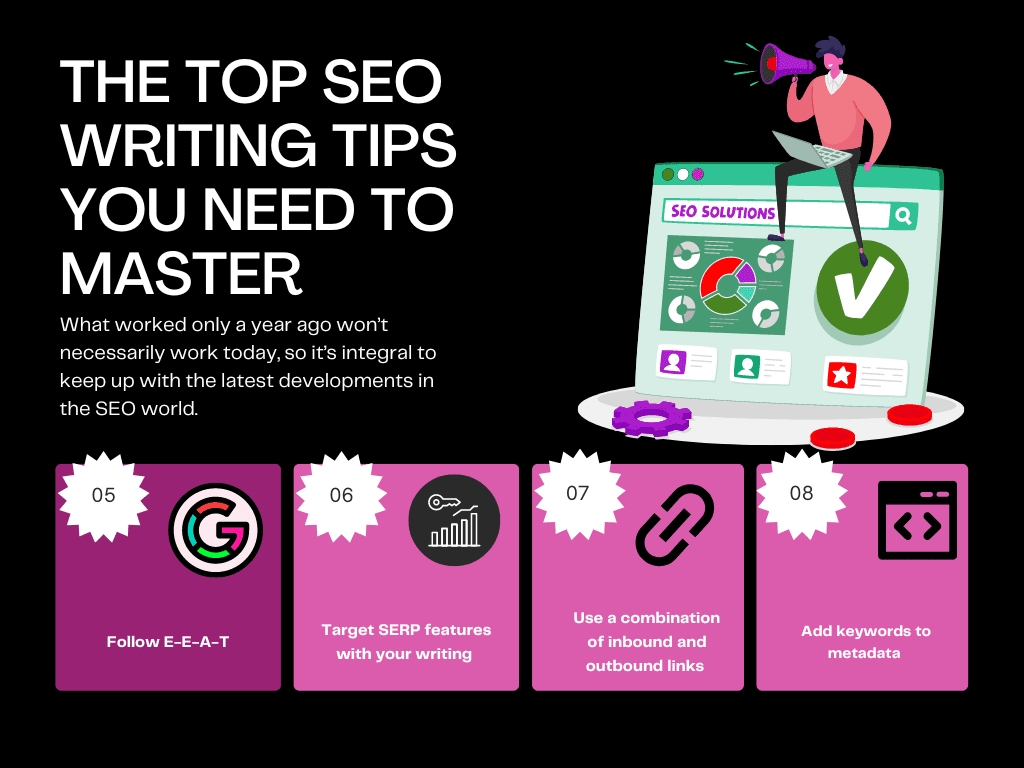
#4: Prioritize Human-Centric Content, with SEO in the Supporting Role
This tip stands out as one of the most crucial principles in mastering SEO writing, and it’s an area where many SEO practitioners still require guidance.
At its core, your content’s primary purpose is to deliver tangible value to your human readers. While securing high search engine rankings remains a laudable objective (and ultimately, the goal), an unwavering focus on catering to search engines at the expense of human engagement is an ill-fated strategy.
But what does it mean to “cater to search engines”?
Imagine, for instance, saturating a 1,000-word blog post with your target keyword to the point where it appears 50 times, resulting in awkward and unnatural prose. Such an approach prioritizes search engines over humans and invites quick detection as keyword spam – an extreme illustration but illustrative of the concept.
Every SEO optimization you implement, whether it involves keyword integration, inbound links, or targeting SERP features, should fundamentally enhance the content’s quality for your human audience, rather than detracting from it.
Therefore, when crafting content for your website, your foremost objective should be to add substantial value to your audience by addressing their questions, solving their problems, and offering unique insights that underscore your expertise and experience.
In practice, this means prioritizing user-centric content first and subsequently incorporating SEO refinements, such as seamlessly integrating keywords in a natural, organic manner.
#5: Embrace E-E-A-T Principles for SEO Success
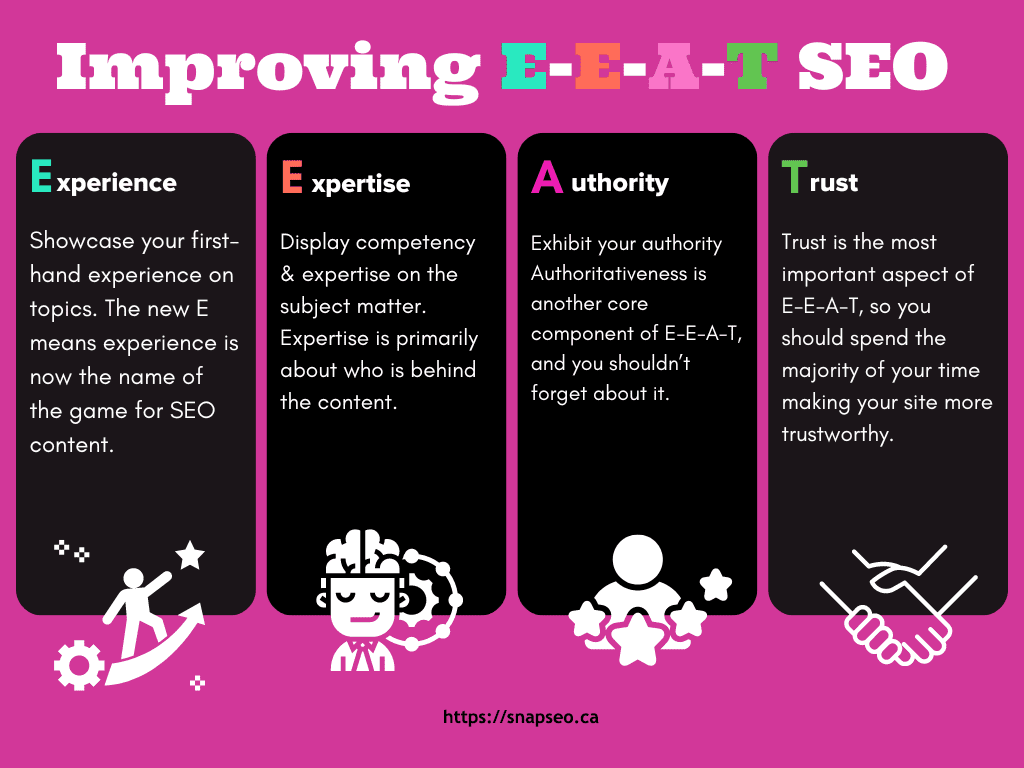
As previously mentioned, Google’s Quality Rater Guidelines now incorporate the acronym E-E-A-T, replacing the former E-A-T. But what exactly does E-E-A-T signify?
E-E-A-T stands for Experience, Expertise, Authoritativeness, and Trustworthiness, encapsulating how Google assesses the quality of content. To attain a high-quality designation for your blog post, video, or landing page, it’s imperative to embody these attributes.
Behind the scenes, Google employs a team of human quality raters who conduct manual evaluations of websites. The assessments conducted by these raters wield substantial influence over Google’s search algorithms. Consequently, infusing E-E-A-T principles into your SEO writing is essential for securing prominent rankings on Google’s Search Engine Results Pages (SERPs).
Let’s delve into the facets of E-E-A-T, starting with “experience.” Google expects you to demonstrate firsthand experience with the subject matter you’re addressing, particularly in the case of product reviews. Incorporating anecdotes, real-life narratives, and personal experiences within your content effectively accomplishes this.
Next, emphasize your “expertise” by providing distinctive insights that showcase your in-depth knowledge. To establish “authoritativeness,” incorporate backlinks and external references, underscoring your content’s credibility. Finally, affirm “trustworthiness” by disseminating precise, up-to-date information that instills confidence in your readers.
Incorporating these E-E-A-T principles into your SEO writing not only aligns your content with Google’s quality standards but also fosters user trust and loyalty.
#6: Harness the Power of Targeting SERP Features
Leveraging SERP features can catapult your online presence to the next level, ultimately securing that coveted position zero.
If you’ve ever conducted a straightforward query on Google and received a prominently displayed, bold response above the organic search results, you’ve encountered a SERP feature. It’s characterized by a format like this:
[Alt tag: A screenshot of a Featured Snippet on Google.]This prime real estate at the top of the search results, accompanied by a link to the source website, represents a position of exceptional influence. Consequently, it’s highly advisable to strategically aim for SERP features whenever the opportunity arises.
To ascertain if your content qualifies for SERP features, Google’s Rich Results Test is a valuable tool at your disposal.
#7: Harness the Synergy of Inbound and Outbound Links
Incorporating links plays a pivotal role in the realm of SEO writing, emphasizing the importance of utilizing both inbound and outbound links within your content.
Inbound links significantly enhance the user experience by establishing a content loop that keeps readers engaged on your website. Furthermore, they wield considerable SEO benefits. A network of internal links simplifies the understanding of your website’s structure for search engine crawlers, ensuring comprehensive indexing and reducing the risk of overlooking vital pages.
Whenever you craft fresh content, such as a blog post, consider cataloging the other web pages related to it and establish meaningful connections through links. For example, if your discussion on Mediterranean meal planning intersects with one of your fitness routines, it’s prudent to hyperlink to a previously authored blog post on the subject.
Outbound links also merit attention, as they contribute to elevating your website’s authority, provided they lead to reputable and trusted external sources.
#8: Incorporate Keywords into Metadata
Title tags, HTML elements that function as the titles for your content within Google’s SERPs, should feature your target keyword. Moreover, while including your keyword in the meta description is advisable, it’s not mandatory. The meta description’s primary role is to captivate readers and entice them to click your link, so integrating a compelling call-to-action (CTA) is equally important.
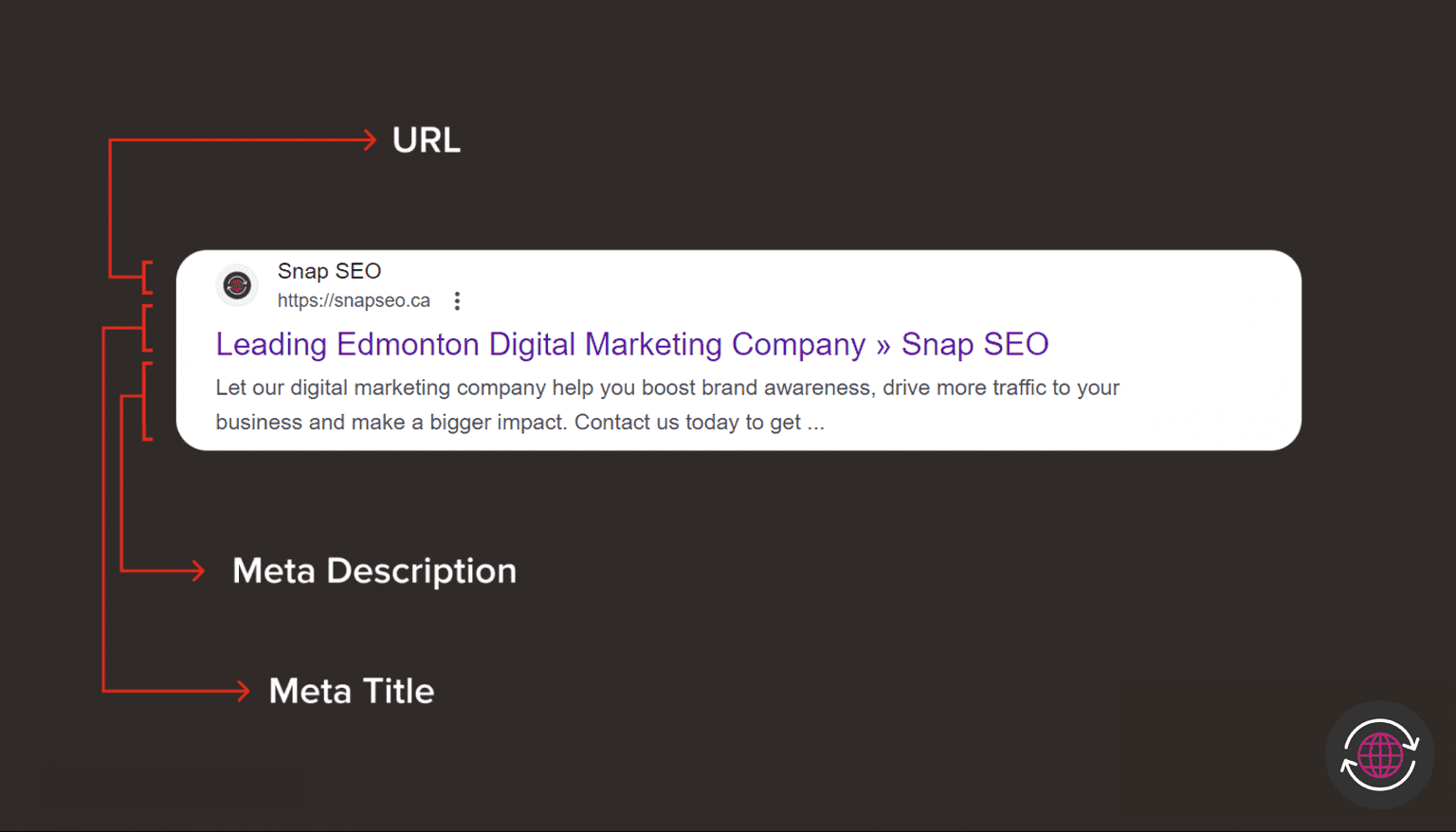
#9: Use Keyword-Rich Alt Text for Images
Every image featured in your post should be accompanied by descriptive alt text. But what exactly is alt text? It comprises a concise line of text that elucidates the image’s content, serving dual purposes. Firstly, it aids readers with visual impairments in comprehending your images. Secondly, it offers search engine crawler bots a means to decipher the relationship between your images and your content since they lack the capability of computer vision. When crafting alt text, ensure the inclusion of the target keyword pertinent to each post.
#10: Rigorous Editing and Proofreading
Concluding the content creation process, every piece you write must undergo rigorous editing and proofreading. Even experienced writers typically produce rough initial drafts. While tools like Grammarly can be invaluable for proofreading, they cannot fully replace the meticulous scrutiny of a human editor. Hence, employing both tools and human oversight is advised.
Key aspects to scrutinize during editing and proofreading encompass:
- Sentence and Paragraph Length: Strive for concise sentences and paragraphs to optimize readability.
- Keyword Usage: Confirm the proper incorporation of keywords in your content.
- Link Integrity: Verify that internal and external links remain functional and unbroken.
- Spelling and Grammar: Eliminate any spelling and grammatical errors to enhance the content’s professionalism.
Upon completing this meticulous review, you can confidently publish your content, ushering in the influx of traffic and conversions.
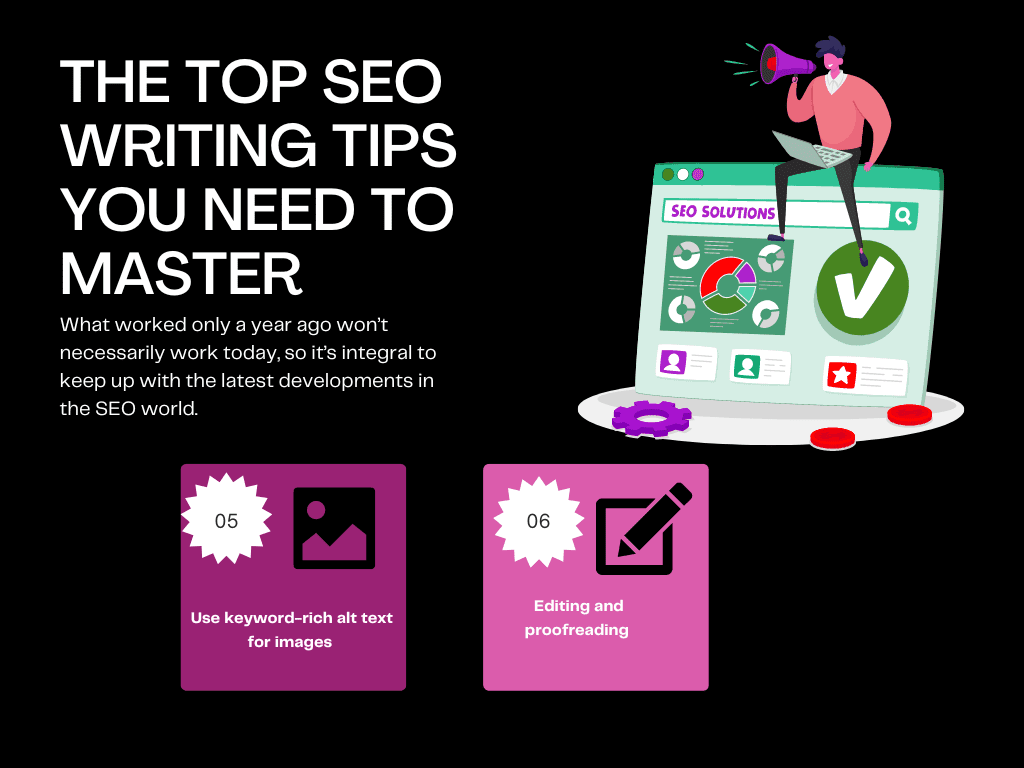
Key Insights: Mastering SEO Writing
These ten steps constitute a blueprint for crafting exceptional SEO content that serves the interests of both search engines and your target audience.
By honing your SEO writing skills, you position yourself to conquer the SERPs, cultivate a devoted readership, and foster the expansion of your business.
If you find yourself lacking the time or expertise to produce top-tier SEO content independently, consider exploring Snap Managed SEO, our comprehensive managed SEO services, and Snap Blogger, our acclaimed five-star content writing service. These offerings can be the key to your SEO success.

